The Intel Xeon E5-2690 is a dual socket compatible processor. We have previously looked at a dual Intel Xeon E5-2690 system, including the power consumption. As we are working with our new Linux benchmark suite, we did want to add some interesting results. Specifically, we wanted to show the fastest multi-threaded results we noted to date. We do need to re-run with our hyper-speed Intel Xeon E5-2687W machine but this should be the fastest until then.
Test Configuration
We updated our test configuration slightly. The new configuration has 64GB of RAM and is using full retail silicon.
- CPUs: 2x Intel Xeon E5-2690 CPUs
- Motherboard: Supermicro X9DR7-LN4F
- Memory: 8x 8GB Kingston 1600MHz RDIMMs
- SSD: Corsair Force3 120GB, OCZ Vertex 3 120GB 2x OCZ Agility 3 120GB
- Power Supply: Corsair AX850 850w 80 Plus Gold
- Chassis: Norco RPC-4220
- Cooling: 2x CoolerMaster Hyper 212 EVOs
- Operating System: Ubuntu 12.04 LTS
Overall this ended up being a nice test platform and is certainly a favorite.
Intel Xeon E5-2690 Benchmarks
Our Linux CPU test suite combines both single threaded and multi-threaded benchmarks. As we expect, some of the tests the dual Intel Xeon E5-2690 setup cannot utilize all of its capacity. Still, it is important to see performance from both angles.
Hardinfo Performance
hardinfo is a well known Linux benchmark that has been around for years. It tests a number of CPU performance aspects.
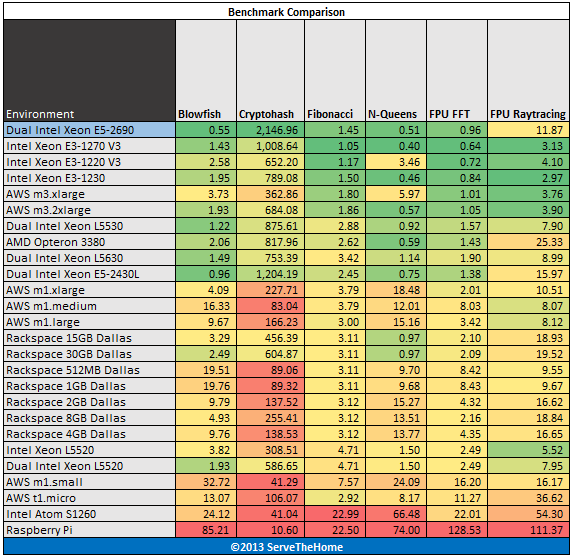
Here we see overall great results in highly-threaded tasks like the cryptohash benchmark. Chips like the Intel Xeon E3-1270 V3 are based on a newer Haswell architecture and are clocked higher. As a result, for single threaded applications, we will see the Haswell Xeon range do well.
UnixBench 5.1.3 Performance
UnixBench may be a defacto standard for Linux benchmarking these days. There are two main versions, one that tests single CPU performance on that tests multiple CPU performance. UnixBench segments these results. We run both sets of CPU tests. Here are the single threaded results:
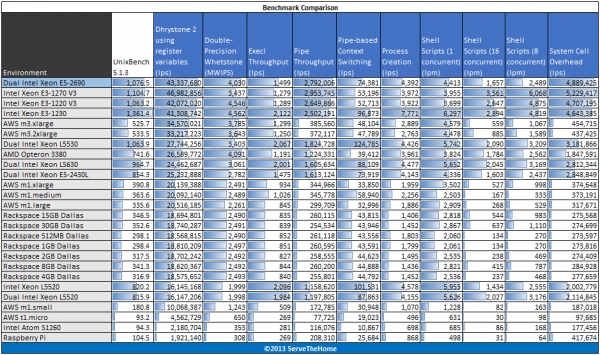
Again in the single-threaded results we see the dual Intel Xeon E5-2690 system perform well. The 20MB of cache and 2.9GHz base clock (3.8GHz turbo) do help keep the processors competitive.
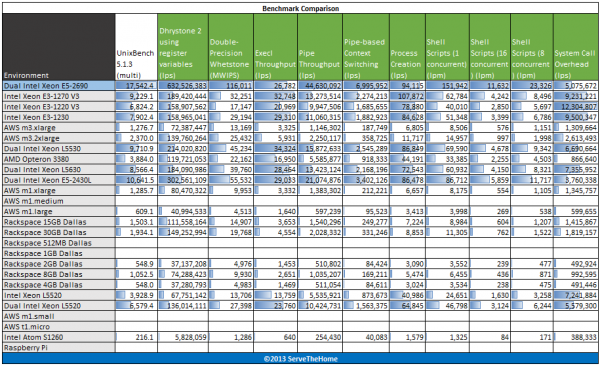
Here we see one of the big reasons people purchase the Intel Xeon E5-2690 systems. 32 threads simply speed through some tests. Overall, very impressive performance.
c-ray 1.1 Performance
c-ray is a very interesting ray tracing benchmark. It provides both consistent results and some clear separation. Ray tracing is generally a great multithreaded CPU benchmark. For this test we use both a simple 7500×3500 render and a more complex 1920×1200 render. Here are the results:
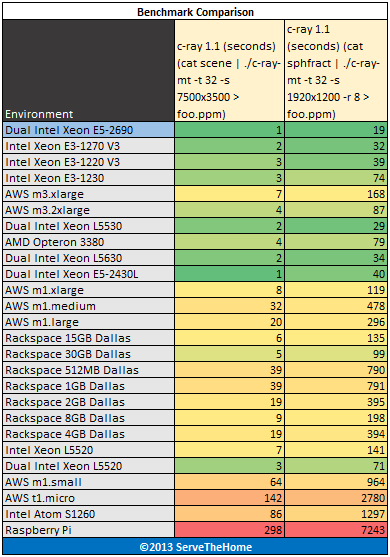
The dual Intel Xeon E5-2690 is one of the key reasons we have both renders in our test suite. It completes the first in only a second and the second render in merely 19. Much faster than anything else we tested thus far.
Crafty Chess Performance
Crafty is a well known chess benchmark. It is also one where we saw issues last time with the Phoronix Test Suite and running on ARM CPUs. Here are the Crafty Chess results from simply running “crafty bench”:
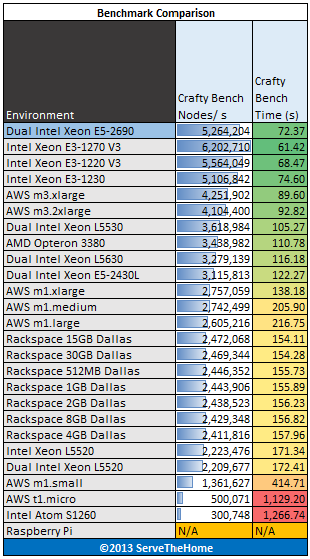
Here we see the impact of the 3.8GHz max turbo boost with the dual Intel Xeon E5-2690 system. The Haswell IPC improvements and higher clock speed again pay off. Still, one is not giving up much in single threaded performance with the dual Intel Xeon E5-2690 configuration.
Phoronix Test Suite Performance
We are using four tests from the Phoronix Test Suite: pts/stream, pts/compress-7zip, pts/openssl and pts/pybench.
- STREAM by John D. McCalpin, Ph.D. is a very well known memory benchmark benchmark. S
- 7-zip compression benchmarks were a mainstay in our Windows suite so we are including it again on the Linux side as a compression benchmark.
- The pts/openssl benchmark is very dependent on the CPU architecture being used
- Python is a widely used scripting language and pyBench is a nice single-threaded Python benchmark.
Here are the results of the Phoronix Test Suite benchmarks:
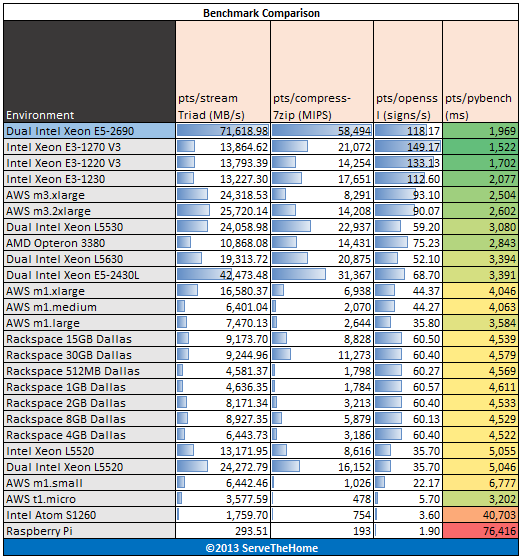
With quad channel memory, the Intel Xeon E5-2690 speeds ahead in memory bandwidth. Likewise highly threaded compression workloads favor the dual Intel Xeon E5-2690 configuration.
Conclusion
Overall, until the Ivy Bridge-EP family Xeons, the Intel Xeon E5-2690 generation is going to be the fastest 135w TDP part around. The massive core count, ability to run in dual socket configurations and large cache keep performance high regardless of the type of work the processors are doing. From the benchmarks we can clearly see performance being solid. The other side of the equation is that the dual socket Xeon E5-2600 systems can have up to 768GB of RAM and lots of PCIe 3.0 expansion. Of course, there is a price premium. The Intel Xeon E5-2690 chips sell for around $1,800 or more on ebay and a retail price is around $2,000. Clearly these chips are priced at a premium, but that is what we expect at this end of the spectrum.





So basically dual xeon e5-2690s are fast.